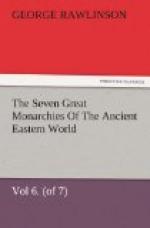It is evident that the entire tract above described must have been at all times a valuable and much coveted region. Compared with the arid and inhospitable deserts which adjoin it upon the north and south, Khorasan, the ancient Parthia and Hyrcania, is a terrestrial Paradise. Parthia, though scantily wooded, still produces in places the pine, the walnut, the sycamore, the ash, the poplar, the willow, the vine, the mulberry, the apricot, and numerous other fruit trees. Saffron, asafoetida, and the gum ammoniac plant, are indigenous in parts of it. Much of the soil is suited for the cultivation of wheat, barley, and cotton. The ordinary return upon wheat and barley is reckoned at ten for one. Game abounds in the mountains, and fish in the underground water-courses. Among the mineral treasures of the region may be enumerated copper, lead, iron, salt, and one of the most exquisite of gems, the turquoise. This gem does not appear to be mentioned by ancient writers; but it is so easily obtainable that we can scarcely suppose it was not known from very ancient times.
The severity of the climate of Parthia is strongly stated by Justin. According to modern travellers, the winters, though protracted, are not very inclement, the thermometer rarely sinking below ten or eleven degrees of Fahrenheit during the nights, and during the daytime rising, even in December and January, to 40 deg. or 50 deg.. The cold weather, however, which commences about October, continues till nearly the end of March, when storms of sleet and hail are common. Much snow falls in the earlier portion of the winter, and the valleys are scarcely clear of it till March. On the mountains it remains much longer, and forms the chief source of supply to the rivers during the spring and the early summer time. In summer the heat is considerable, more especially in the region known as the “Atak;” and here, too, the unwholesome wind, which blows from the southern desert, is felt from, time to time as a terrible scourge. But in the upland country the heat is at no time very intense, and the natives boast that they are not compelled by it to sleep on their house-tops during more than one month in the year.
The countries by which Parthia Proper was bounded were the following: Chorasmia, Margiana, Aria, Sarangia, Sagartia, and Hyrcania.
Chorasmia lay upon the north, consisting of the low tract between the most northerly of the Parthian mountain chains and the old course of the Oxus. This region, which is for the most part an arid and inhospitable desert, can at no time have maintained more than a sparse and scanty population. The Turkoman tribes which at the present day roam over the waste, feeding their flocks and herds alternately on the banks of the Oxus and the Tejend, or finding a bare subsistence for them about the ponds and pools left by the winter rains, represent, it is probable, with sufficient faithfulness, the ancient inhabitants, who, whatever their race, must always have been nomads, and can never have exceeded a few hundred thousands. On this side Parthia must always have been tolerably safe from attacks, unless the Cis-Oxianian tribes were reinforced, as they sometimes were, by hordes from beyond the river.




